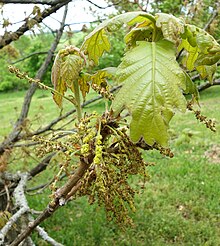| Daimyo oak | |
|---|---|

| |
| Conservation status | |
 Least Concern (IUCN 2.3) | |
| Scientific classification | |
| Kingdom: | Plantae |
| Clade: | Tracheophytes |
| Clade: | Angiosperms |
| Clade: | Eudicots |
| Clade: | Rosids |
| Order: | Fagales |
| Family: | Fagaceae |
| Genus: | Quercus |
| Subgenus: | Quercus subg. Quercus |
| Section: | Quercus sect. Quercus |
| Species: | Q. dentata |
| Binomial name | |
| Quercus dentata Thunb. | |
| Synonyms | |
List
| |
Quercus dentata, also called Japanese emperor oak, daimyo oak, or Korean oak (Japanese: 柏, kashiwa; traditional Chinese: 柞櫟; simplified Chinese: 柞栎; pinyin: zuòlì; Korean: 떡갈나무, tteokgalnamu), is a species of oak native to East Asia (Japan, Korea and China). The name of the tree is often translated as "sweet oak" in English to distinguish it from Western varieties. It is placed in section Quercus.
Description
Quercus dentata is a deciduous tree growing up to 20–25 metres (66–82 feet) tall, with a trunk up to 1 m (3 ft 3 in) in diameter. Its foliage is remarkable for its size, among the largest of all oaks, consisting of a short hairy petiole, 1–1.5 centimetres (3⁄8–5⁄8 inch) long, and a blade 10–40 cm (4–15+1⁄2 in) long and 15–30 cm (6–12 in) broad, with a shallowly lobed margin; the form is reminiscent of an enormous pedunculate oak leaf. The leaves are often retained dead on the tree into winter. Both sides of the leaf are initially downy with the upper surface becoming smooth.
The flowers are produced in May; the male flowers are pendulous catkins. The female flowers are sessile, growing near the tips of new shoots, producing acorns 1.2–2.3 cm long and 1.2–1.5 cm broad, in broad, bushy-scaled cups; the acorns mature in September to October.
Cultivation outside East Asia
Quercus dentata was introduced to the British Isles in 1830, where it is occasionally grown in botanical gardens. It is usually smaller in cultivation than in the wild, growing to a small angular tree or large irregular shrub. Notable specimens include one at Osterley Park, 14 m (46 ft) tall and 1.5 m girth, and the largest, 18 m (59 ft) tall, at Avondale Forest Park, County Wicklow, Ireland.
Culinary uses
In Korean cuisine, its acorns (in Hangul: 도토리, dotori) have been used since the Three Kingdoms. A notable food is dotorimuk.
In Japanese cuisine, its leaves are used as a wrapping for kashiwa mochi.
References
- "Quercus dentata Thunb.". World Checklist of Selected Plant Families. Royal Botanic Gardens, Kew – via The Plant List. Note that this website has been superseded by World Flora Online
- English Names for Korean Native Plants (PDF). Pocheon: Korea National Arboretum. 2015. p. 599. ISBN 978-89-97450-98-5. Archived from the original (PDF) on 25 May 2017. Retrieved 16 December 2016 – via Korea Forest Service.
- ^ Huang, Chengjiu; Zhang, Yongtian; Bartholomew, Bruce. "Quercus dentata". Flora of China. Vol. 4. Retrieved March 3, 2016 – via eFloras.org, Missouri Botanical Garden, St. Louis, MO & Harvard University Herbaria, Cambridge, MA.
- Denk, Thomas; Grimm, Guido W.; Manos, Paul S.; Deng, Min & Hipp, Andrew L. (2017-11-02). "Appendix 2.1: An updated infrageneric classification of the oaks" (xls). figshare. doi:10.6084/m9.figshare.5547622.v1. Retrieved 2023-02-17.
- Mitchell, A. F. (1974). "Field Guide to Trees in Britain and Europe." Collins.
- Phillips, R. (1978). "Trees in Britain, Europe and North America." Ward Lock.
- Lancaster, R. (1981). 'Hillier's Manual of Trees & Shrubs," 5th ed. Hillier and Sons.
- Quercus dentata, with photos (pdf file; in Japanese)
External links
- World Conservation Monitoring Centre (1998). "Quercus dentata". The IUCN Red List of Threatened Species. 1998. IUCN: e.T31294A9617239. doi:10.2305/IUCN.UK.1998.RLTS.T31294A9617239.en.
- line drawing, Flora of China Illustrations vol. 4, fig. 360, 1